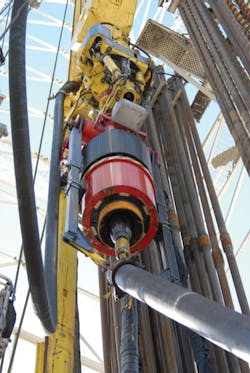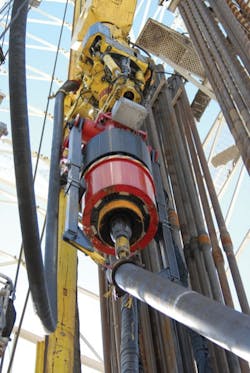Sakhalin II nears full production
Jessica Tippee
Editorial Intern
Sakhalin II in the sub-Arctic Sea of Okhotsk is nearly operating at full capacity with the completion of the fourth gas well drilled from the Lunskoye platform off Sakhalin Island.
The project consists of three offshore platforms, 300 km (186 mi) of offshore pipelines, two parallel 800 km (497 mi) of onshore oil and gas pipelines, an offshore processing facility, an oil export terminal, and an LNG plant.
At full capacity, expected in 2010, Sakhalin II will produce 9.6 million metric tons (10.58 tons) a year of LNG. The project will add 5% to the world’s LNG capacity, and fill 8% of Japan’s gas needs and 5% of South Korea’s gas needs. Shell estimates Sakhalin’s oil and gas fields hold recoverable reserves of about 17.3 tcf of natural gas, and 1 Bbbl of oil and natural gas liquids.
Sakhalin Energy Investment Co. Ltd. (Sakhalin Energy), the operator of Sakhalin II, is a joint venture of Gazprom (50% plus one share), Shell (27.5% minus one share), Mitsui (12.5%), and Mitsubishi (10%). The Energy Information Administration estimates the cost at more than $20 billion.
Ian Craig, CEO of Sakhalin Energy, says Sakhalin II is a model for future projects because of the combination of global resources and national expertise.
"We’ve been helped immensely by the strength of the joint venture. Gazprom with its tremendous onshore pipelines experience, Shell with its technology, LNG, and offshore developments, Mitsui and Mitsubishi with their huge knowledge of LNG markets," Craig says.
Sakhalin II’s three offshore platforms must function in extreme weather such as ice, typhoons, and earthquakes.
Piltun-Astokhskoye A (PA-A, or "Molikpaq"), the first offshore platform completed during Phase I in 1998, has produced more than 100 MMbbl of oil since 1999. Situated 16 km (10 mi) off the island’s northeast coast, the platform is 120 m (394 ft) wide, weighs 37,523 metric tons (41,362 tons), and is ballasted with 278,000 cu m (9.8 million cu ft) of sand.
Lunskoye-A (Lun-A), 15 km (9.3 mi) off Sakhalin’s northeast coast lies in 48 m (157 ft) of water. Now operating at full capacity with the completion of the fourth gas well, the platform is expected to produce more than 50 MMcm/d (1.77 MMcf/d) of gas and 50,000 b/d of natural gas liquids.
Piltun-Astokhskoye-B (PA-B), 12 km (7.5 mi) off the island’s northeast coast, stands 121 m (397 ft) from the sea floor to the top of the derrick, and lies in 30 m (98 ft) of water. The platform was designed to produce 70,000 b/d of oil and 3 MMcm/d of gas.
Earthquakes with magnitudes of 6.4 and 7.6 on the Richter scale have occurred in the region in the last 15 years. Lun-A and PA-B’s topsides are connected by sliding joints to the more than 20 m (65 ft) wide and 56 m (184 ft) tall concrete legs. PA-B’s topsides weigh more than 28,000 metric tons. Lun-A’s topsides weigh more than 22,000 metric tons (24,251 tons). In an earthquake, the topsides can operate independently from the legs in a pendulum motion to prevent damage to the platforms. According to Shell, the design can withstand an earthquake measuring 8.0 on the Richter scale, or more than 30,000 metric tons (33,069 tons) of pressure on the platforms’ legs. An earthquake of that magnitude may occur on Sakhalin Island once in 3,000 years.
Two specially built T-shaped barges, each the size of two football fields, towed the PA-B and Lunskoye-A topsides platforms 3,000 km (1,864 mi) from the Samsung Heavy Industries shipyard in South Korea.
To accomplish installation, the barges sailed into position between already installed platform legs and the topsides were lowered gradually to settle on the legs. The PA-B’s 28,000-metric ton topside makes it almost as heavy as three Eiffel Towers — it set a world record for the heaviest topside ever installed this way.
Winters in the sub-arctic environment can experience temperatures as low as -45º C (-49º F). Combined with the arctic winds and high humidity, the chill factor drops to -70º C (-94º F). Ice surrounds the platforms from December to May.
The platforms’ concrete legs — each wider than 20 m (65 ft) and 56 m (184 ft) tall — were built in Vostochny port in Russia and barged to the site. The size helps withstand earthquakes and the rounded shape helps ice floes slide around them.
"It sounds like an icebreaker ripping through pack ice and it makes the platform gently rock," says Egbert Menzinga, chief technician on the PA-B platform. "Sometimes sheets of ice edge up platform legs, peel backwards, and crash back down on the frozen sea."
Due to the weather, underwater pipelines were installed to transport the hydrocarbons ashore all year. Buried 5 m (16 ft) beneath the seabed where the sea is less than 30 m (98 ft) deep, concrete protects the pipelines. The pipelines also are equipped with an electronic leak-detection which stops the flow of oil and gas if pressure drops.
As a response to a recommendation by the Independent Scientific Review Panel, the offshore pipelines were rerouted to avoid western gray whales in the region. According to the International Union for Conservation of Nature, the western gray whales are "critically endangered." Sakhalin Energy won the 2008 Environmental Project of the Year award from Russia’s Ministry of Environment and Natural Resources for its whale protection program.
Sakhalin II marks many firsts for Russia, including, according to Gazprom, the following:
- The first Production Sharing Agreement (PSA) project executed and signed in Russia
- First oil and gas production platform on the Russian shelf
- First LNG production plant in Russia
- First Russian gas entering the Asia/Pacific region and North American coast.
The first year-round oil export from the new Oil Export Terminal at Aniva Bay took place in December 2008. The LNG plant was officially inaugurated on Feb. 18, 2009, and the first LNG cargo left for Japan in March 2009.
Sakhalin I
The Sakhalin I Project is an oil and gas development on the northeast shelf of Sakhalin Island. Exxon Neftegas Ltd. is the operator for the Sakhalin-1 Consortium (ExxonMobil interest 30%), affiliates of Rosneft, the Russian state-owned oil company, RN-Astra (8.5%) and Sakhalinmorneftegas-Shelf (11.5%); the Japanese consortium SODECO (30%); and the Indian state-owned oil company ONGC Videsh Ltd. (20%).
Declared commercial in October 2001, the project is comprised of the Chayvo, Odoptu and Arkutun-Dagi fields. Total recoverable reserves are estimated to be 2.3 Bbbl of oil and 17.1 tcf of natural gas.
The Chayvo field is developed from both offshore and onshore facilities. Oil and gas is produced from the Orlan offshore platform. The 20-well concrete structure serves as the offshore drilling and living quarters and is used to develop the southwestern flank of the main Chayvo zone. Installation of Orlan was completed in July 2005 and drilling operations using the advanced batch drilling process started in December 2005. The Orlan drilling rig is operated on the platform year-round. Offshore processing facilities are minimal, with a full well stream sent to shore.
Onshore, state-of-the-art extended reach drilling (ERD) technology cut the capital and operating costs compared to large offshore structures and minimized the environmental. Shore-based ERD reaches under the seabed to distances exceeding 11 km (7 mi) to tap the northwestern flank of the main Chayvo oil zone. Records have been set for depth, horizontal reach, and drilling speed. In February 2008, the Yastreb Z-12 well set a new world record for extended reach drilling by achieving a measured depth of 11,680 m (38,322 ft).
Sakhalin II LNG export update
Sakhalin Energy may boost LNG exports this year to 5 million metric tons (5.5 million tons) from the originally planned 3 million metric tons (3.3 million tons), according to Gazprom deputy CEO, Alexander Medvedev, speaking earlier this year.
"The way the situation is developing now indicates that exports may exceed 5 million metric tons," said Medvedev, who is also general director of Gazprom Export LLC. "Exports are being made at an accelerating pace. Fifteen standard lots of LNG were planned, but 17 have already been shipped."
Gazprom independently sold two lots of LNG and plans to ship three more by year-end.
Beginning in 2010, Gazprom "will have access to up to 1 million metric tons (1.1 million tons) of LNG exports a year."


